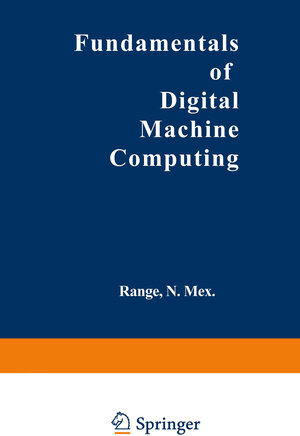
×
![Buchcover ISBN 9783642490316]()
Fundamentals of Digital Machine Computing
von G. HintzeInhaltsverzeichnis
- 1 The Role and Principal Attributes of Digital Computers.
- 1-1. The Universality of Digital Computers.
- 1-2. Digital Computers as Logical Machines.
- 1-3. Large Memory Capacity.
- 1-4. Computational Rapidity.
- 1-5. General Systems Configuration.
- 1-6. The Computer Family Tree.
- 2 Binary Numbers and Codes and their Machine Representation.
- 2-1. The Binary Number System.
- 2-2. The Octal System as Bridge between Decimal and Binary.
- 2-3. Number Conversion.
- 2-4. Binary Codes.
- 2-5. Representation of Negative Numbers.
- 2-6. Fixed Point Number Ranges.
- 2-7. Scale Factoring.
- 2-8. Floating Point Numbers.
- 2-9. Initial Computer Input.
- 3 The Principles of Logic in Computers.
- 3-1. Relationship of Logical Concepts to Computer Circuits.
- 3-2. Boolean Algebra as Symbolic Logic.
- 3-3. Some Useful Theorems of Boolean Algebra.
- 3-4. Basic Elements of the Computer.
- 3-5. Logical Description of Basic Elements.
- 3-6. Minimization of Logical Functions.
- 3-7. Logical Synthesis of Combinational Circuits.
- 3-8. Logical Analysis of Combinational Circuits.
- 3-9. The Logic of Combinational Circuits with Several Outputs.
- 3-10. Logical Synthesis of Sequential Circuits.
- 3-11. Design of an Odd-Sequence Counter.
- 3-12. The Logic of the Entire Computer.
- 4 Arithmetic Operations of the Machine.
- 4-1. The Logic of Binary Addition and Subtraction.
- 4-2. Serial and Parallel Binary Addition.
- 4-3. Addition with Accumulators.
- 4-4. Machine Subtraction.
- 4-5. BCD Addition and Complementation.
- 4-6. Considerations for Machine Multiplication.
- 4-7. Serial Binary Multiplication.
- 4-8. Parallel Binary Multiplication.
- 4-9. BCD Multiplication.
- 4-10. Considerations for Machine Division.
- 5 The Instruction Code of the Computer.
- 5-1. Basic Computer Operations.
- 5-2. Instruction Format.
- 5-3. Coding of Instructions.
- 5-4. General Classes of Instructions.
- 5-5. Operational Instructions.
- 5-6. Control Instructions.
- 5-7. Instruction Modification.
- 5-8. Editing Instructions.
- 5-9. Instruction Execution.
- 6 Principles and Examples of Programming.
- 6-1. Mathematical Methods for Digital Computers.
- 6-2. Diagramming the Program.
- 6-3. Writing the Code.
- 6-4. Simple Arithmetic Problems.
- 6-5. Iterative Processes.
- 6-6. Polynomial Evaluation.
- 6-7. Solution of Simultaneous Linear Equations.
- 6-8. Matrix Operations.
- 6-9. Searching and Sorting.
- 6-10. Numerical Solution of Differential Equations.
- 6-11. A Complete Program for a Rocket Trajectory.
- 7 Automatic Programming.
- 7-1. Meaning of Automatic Programming.
- 7-2. Principles of Language Design.
- 7-3. The Structure of ALGOL.
- 7-4. Basic Considerations for Compilers.
- 7-5. The IT Compiler.
- 7-6. The Listing Process.
- 7-7. The Decomposition Process.
- 7-8. Compiler Summary.
- Appendix A. Summary of Instructions by Alphabetic Code.
- Appendix B. Powers of Two.
- List of References.



